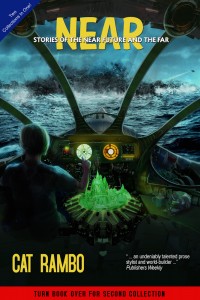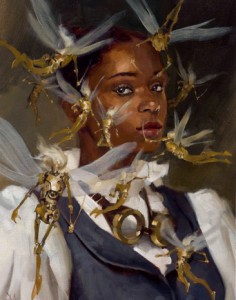What is flash fiction? As the name would imply, it’s short. Short, short, short. It’s sometimes called short-short stories for that reason. People define that length in varying numbers: the Florida Review used to award $100 and a crate of oranges to the winner of their short-short story competition, while 10 Flash Quarterly‘s editor/publisher K.C. Ball says it’s got to clock in at a 1000, and others have stretched it as far as 2000 words (which to my mind wanders into actual short story territory).
Others go much shorter, pointing to Hemingway’s famous six word story: “For sale: baby shoes, never used.” There’s twitter fiction magazines, like Thaumatrope, Nanoism, and 140 Characters (which last posted in March, alas). I actually fall in this camp, but to explain why, I need to explain the appeal that flash fiction holds for me.
Flash fiction is concentrated fiction, undiluted by digression or subplot. A flash story is an arrow thrilling in the reader’s heart, something that hits dead on. It uses the story structure in miniature and gets at the heart of what a story must do: something must change. In traditional stories, and in many of their flash counterparts, the change occurs in the main/viewpoint character. In the best ones, there is often an internal as well as external change: In conquering her fear of spiders, Polly defeats the Squids From Beyond. Because flash is short, often that’s not met and the change is one or the other. Other kinds of change might involve the setting, or some other major factor within the confines of the story.
But there is another kind of change that can occur, and that is in the reader, either emotionally or in terms of their expectations. That’s what happens in the Hemingway story. We begin with what is surely an exemplar of cuteness, because who doesn’t like baby shoes? And then we are abruptly moved away in the next two words – they’re for sale, we think, and immediately ask why? And then the hammer of tragedy: the shoes have never been used, and we supply the rest. Dead baby. Our understanding, our expectations, our emotions, all can be shifted by a piece of flash fiction. We are changed. Good fiction, or at least fiction that falls within a particular definition of “good”, changes us.
Not every flash piece does this. Flash lends itself well to humor, to the shaggy dog story, to the punchline at the end (another change in the reader, as we are moved from the expectant moment of story beginning to the ultimate laugh or groan) and it’s a good length for it. The longer the story gets, the better that punchline needs to be, or else a reader feels they’ve wasted their time. You’ll listen more readily to the office storyteller’s cleverly shaped anecdote than you will Kim from accounting, who can’t seem to stick to the point when she’s recounting the story of how the office copier got broken at the holiday party.
Sometimes flash fiction slides over into prose poetry territory. I’ll talk about that more some other time, particularly as the time approaches for the workshop I’m giving on literary and speculative fiction for Clarion West next spring.
At any rate, writing flash fiction is a useful exercise for writers. Anything that makes us practice writing is surely a good thing, and sitting down to write a flash piece fulfills that. Beyond that, it’s very satisfying to rise from the desk knowing you’ve written something in its entirety, as opposed to the tiresome nature of a novel, which swallows hours and hours of writing while swelling as slowly as ice accreting.
You can use flash to try out new techniques. One of the exercises I’m going to try tonight, in fact, draws on a piece I heard Gra Linnaea read at World Fantasy Con, written all in future tense, which I’m going to read to the class before challenging them to write their own pieces in future tense. Another draws on Randy Henderson’s most excellent THE MOST EPICLY AWESOMEST STORY! EVER!!, which I’ll use to challenge the class to think about bad writing vs. good.
Many new writers are hungry for publications, and writing flash is a good strategy for garnering some. Flash markets, by their nature, consume a lot of pieces, and where a market that publishes one story each month is buying only that one story, a flash market is buying a much larger number. Every Day Fiction, for example, runs a flash piece each day. The shorter a piece is, the easier it is on an editor’s budget.
Some resources for people who want to read flash: I used Sudden Fiction and Sudden Fiction International in a flash writing class I taught at Hopkins. For some terrific examples of the form, try Russell Edson’s work.
Enjoy this writing advice and want more like it? Check out the classes Cat gives via the Rambo Academy for Wayward Writers, which offers both on-demand and live online writing classes for fantasy and science fiction writers from Cat and other authors, including Ann Leckie, Seanan McGuire, Fran Wilde and other talents! All classes include three free slots.
Prefer to opt for weekly interaction, advice, opportunities to ask questions, and access to the Chez Rambo Discord community and critique group? Check out Cat’s Patreon. Or sample her writing here.







